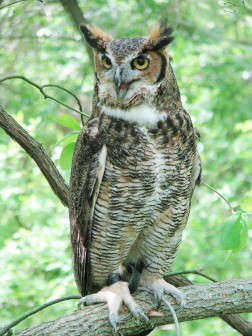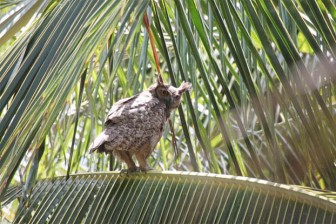The Great Horned Owl (Bubo virginianus) is a large, bulky, barrel-shaped owl. This owl has a broad face with well-defined facial discs and large golden yellow eyes. Its large “horns” are actually tufts of feathers. Brownish in colour and mottled with white and darker brown, it has a broad white band across its throat and the underside is barred with black and white.
This owl ranges from North America, Central America and South America. It is the largest owl in South America, and interestingly, does not exist in Guatemala, El Salvador, from Nicaragua to Panama, Amazonia or the West Indies. The Great Horned Owl however, does exist in Guyana but is considered “uncommon”. It can be heard in the Botanical Gardens and sometimes in bush islands of the North Rupununi and is easily recognized by its upright stocky shape and ear tufts, and its call, a deep, resonating “whoo hoo, whoo, whoo hoo”.
The Great Horned Owl is nocturnal, it watches for prey from a high perch, then swoops to the ground to capture it. Its talons are extremely powerful, and can exert crushing power up to 300 pounds per square inch, killing prey instantly. As in all owls, its flight feathers are stiff but buffered with softer feathers to ensure a soundless flight and ambush of prey. The eyes of a Great Horned Owl are nearly as large as humans’ and fixed in their bone sockets. As it cannot move its eyes to see, it must turn its head and can rotate its head a full 270 degrees.
The owl’s large eyes ensure excellent night vision but it also has keen hearing; its eye disks are shaped to funnel sound towards its ears, and one ear is slightly higher than the other, giving incredible depth perception and accuracy in pinpointing prey in the dark. This owl will eat just about anything, and preys on rodents, birds, reptiles and bats; it will take prey up to two times its weight and has been known to take small dogs and cats as well.

The Great Horned Owl reaches maturity at about 2 years of age. When looking for a mate, the male owl puffs his chest and neck until he resembles a large white ball, and emphatically hoots to a female. If she is receptive, she hoots back in a slightly higher pitch. Once mated, they do not build a nest but take over the nests of other large birds or will lay eggs in the cavity of a hollow tree, platform, deserted buildings or rocks. The male will select the nesting site, fly over it and stomp on it to show the female that this is where they should nest. The female usually produces a clutch of 2 eggs which she alone will incubate for about a month; during this time, the male hunts and brings food for her. The young leave the nest when they are about 10 – 12 weeks old and fly off to find their own territory.
All Great Horned Owls are permanent residents of their territories and as they are top predators, their presence is an indicator of a healthy environment. IUCN Redlist of Threatened species lists the Great Horned Owl as “Least Concern” with a stable population.
Rain forests are rich in biodiversity and are home to many different plants and animals as well as indigenous communities.
Humans, even those who don’t live in the rain forest, rely on it for resources such as building materials (wood and lianas), medicine and fruits.

Rain forests also provide essential environmental services for life on earth; they create soil as well as prevent soil erosion, produce oxygen through photosynthesis, maintain clean water systems, and are a key defence against climate change.
The Iwokrama Rain Forest is 371,000 hectares, located in the heart of Guyana. Our mission is to develop strategies for conservation and sustainable development for local people in Guyana and the world at large.
We are involved in timber, tourism and training. Come and visit us in the rain forest or at http://www .iwokrama.org.





